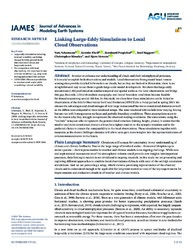Linking Large‐Eddy Simulations to Local Cloud Observations
Schemann, Vera; Ebell, Kerstin; Pospichal, Bernhard; Neggers, Roel; Moseley, Christopher; Stevens, Bjorn, 2020: Linking Large‐Eddy Simulations to Local Cloud Observations. In: Journal of Advances in Modeling Earth Systems, Band 12, 12, DOI: 10.23689/fidgeo-4013.
 |
Dokument öffnen: |
In order to enhance our understanding of clouds and their microphysical processes, it is crucial to exploit both observations and models. Local observations from ground‐based remote sensing sites provide detailed information on clouds, but as they are limited in dimension, there is no straightforward way to use them to guide large‐scale model development. We show that large‐eddy simulations (LES) performed on similar temporal and spatial scales as the local observations can bridge this gap. Recently, LES with realistic topography and lateral boundary conditions became feasible for domains spanning several 100 km. In this study, we show how these simulations can be linked to observations of the Jülich Observatory for Cloud Evolution (JOYCE) for a 9‐day period in spring 2013. We discuss the advantages and disadvantages of very large versus small but more constrained domains as well as the differences compared to more idealized setups. The semi‐idealized LES include time‐varying forcing but are run with homogeneous surfaces and periodic boundary conditions. These assumptions seem to be the reason why they struggle to represent the observed varying conditions. The simulations using the “realistic” setup are able to represent the general cloud structure (timing, height, phase). It seems that the smaller and more constrained domain allows for a tighter control on the synoptic situation and is the preferred choice to ensure the comparability to the local observations. These simulations together with measures as the shown Hellinger distance will allow us to gain more insights into the representativeness of column measurements in the future. Plain Language Summary:
Clouds are still a cause for uncertainty in our understanding of climate and climate feedbacks. Due to the large range of involved scales—from small droplets up to storm systems—their representation in weather and climate models is an ongoing challenge. While new and sophisticated measurements of the atmospheric column could provide new insights into important processes, their linking to models is not trivial and is ongoing research. In this study, we are presenting and exploring different approaches to combine local observations of clouds with state‐of‐the‐art high‐resolution simulations. And we are presenting a setup, which shows a promising representation of the observed clouds and is constrained enough to be applicable for long‐term statistics—one of the key requirements for improvements and evaluation clouds in of weather and climate models. Key Points:
Large‐eddy simulations including external variability can bridge the gap between ground‐based observations of clouds and large‐scale models.
For comparison with local observations, it is important to take external variability (e.g., large‐scale forcing and surface) into account.
ICON‐LEM offers new possibilities to simulate small scales while considering external variability.
Statistik:
ZugriffsstatistikSammlung:
This is an open access article under the terms of the Creative Commons Attribution License, which permits use, distribution and reproduction in any medium, provided the original work is properly cited.

